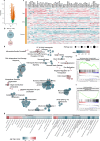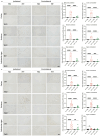Tet2 loss and enhanced ciliogenesis suppress α-synuclein pathology
- PMID: 40189544
- PMCID: PMC11974201
- DOI: 10.1186/s40478-025-01988-z
Tet2 loss and enhanced ciliogenesis suppress α-synuclein pathology
Abstract
There are no approved treatments that slow Parkinson's disease (PD) progression and therefore it is important to identify novel pathogenic mechanisms that can be targeted. Loss of the epigenetic marker, Tet2 appears to have some beneficial effects in PD models, but the underlying mechanism of action is not well understood. We performed an unbiased transcriptomic analysis of cortical neurons isolated from patients with PD to identify dysregulated pathways and determine their potential contributions to the disease process. We discovered that genes associated with primary cilia, non-synaptic sensory and signaling organelles, are upregulated in both early and late stage PD patients. Enhancing ciliogenesis in primary cortical neurons via sonic hedgehog signaling suppressed the accumulation of α-synuclein pathology in vitro. Interestingly, deletion of Tet2 in mice also enhanced the expression of primary cilia and sonic hedgehog signaling genes and reduced the accumulation of α-synuclein pathology and dopamine neuron degeneration in vivo. Our findings demonstrate the crucial role of TET2 loss in regulating ciliogenesis and potentially affecting the progression of PD pathology.
Keywords: Parkinson’s disease; Primary cilia; Tet2; α-synuclein.
© 2025. The Author(s).
Conflict of interest statement
Declarations. Consent for publication: Not applicable. Competing interests: PB declares employment for F Hoffmann-La Roche and stock ownership for F Hoffmann-La Roche, Acousort AB, Axial Therapeutics, Enterin Inc and Kenai Therapeutics. Ethics approval: All experiments were done with approval from the ethics committee of the Van Andel Institute.
Figures





References
-
- Braak H, Del Tredici K, Rüb U, de Vos RAI, Jansen Steur ENH, Braak E (2003) Staging of brain pathology related to sporadic Parkinson’s disease. Neurobiol Aging 24:197–211 - PubMed
Publication types
MeSH terms
Substances
Grants and funding
LinkOut - more resources
Full Text Sources
Medical
Molecular Biology Databases

